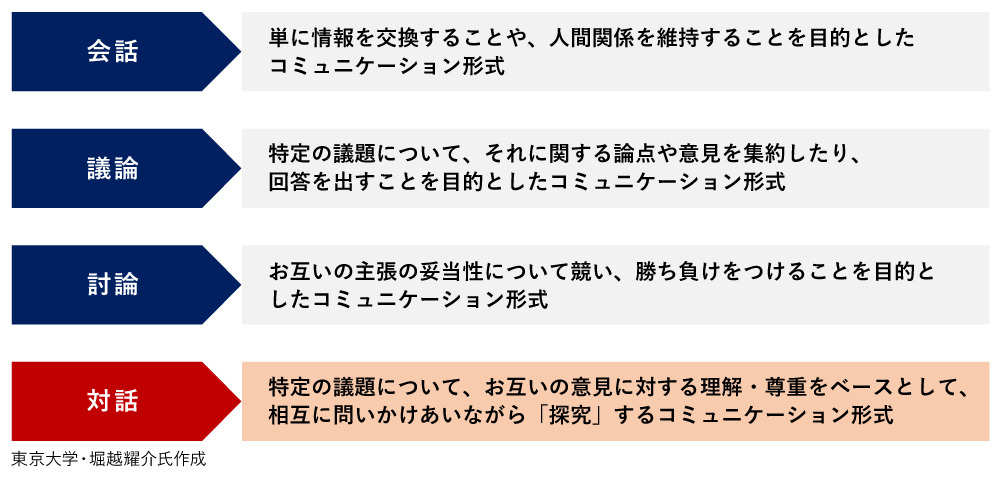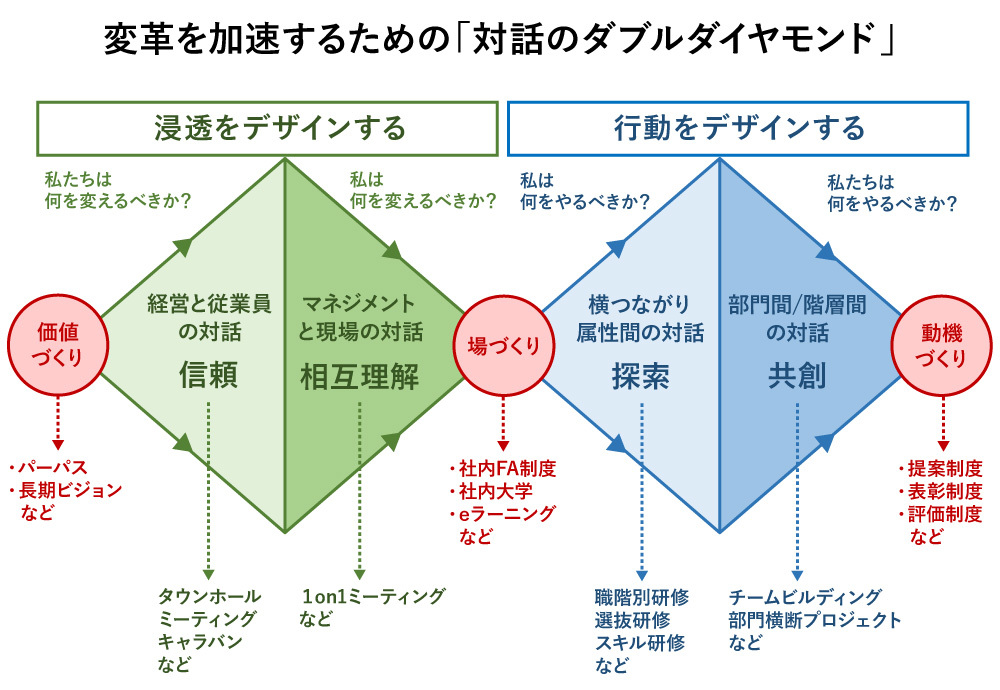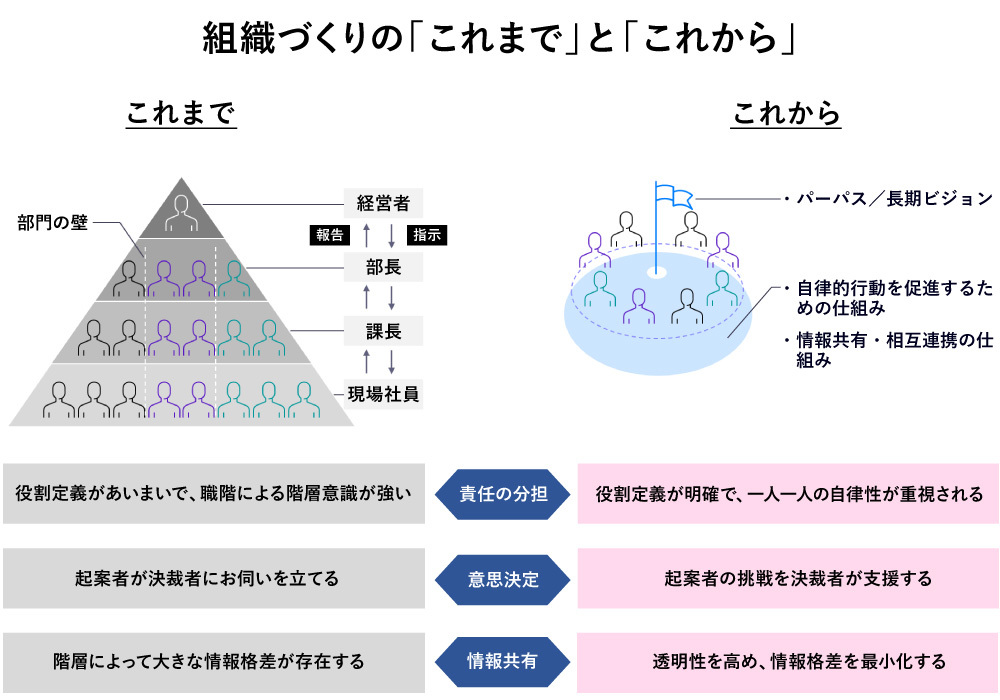"Dialogue" is gaining attention as a new trend in internal communication.
- To embed newly established purpose statements and long-term visions, management and employees engage in dialogue through town hall meetings and similar forums.
- Managers and frontline employees engage in dialogue through 1-on-1 meetings to advance daily operations.
- Employees from different departments or backgrounds engage in dialogue following new projects, management integration, or group reorganization.
And so on.
Dialogue is becoming an indispensable element for smoothly advancing the permeation of management policies, the establishment of corporate culture, and new challenging actions across various workplaces.
However, many Japanese companies are not accustomed to driving initiatives through "dialogue." Consequently, while there is an intuitive sense that "dialogue is indispensable for driving change," there is currently no established methodology for designing the overall framework to link it to transformation. This includes questions like: "Who needs to engage in what kind of dialogue?" "Where should dialogue begin, and how can its scope be expanded?" and "How can dialogue be connected to actual challenging actions, rather than ending as a temporary measure?"
In this article, Naota Nakamachi from Dentsu Inc. Corporate Branding Department, who has extensive practical experience in internal communications, explains the approach for introducing and developing actionable dialogue communication. This is presented incorporating insights and practical experience from Yosuke Horikoshi of the University of Tokyo, who promotes building a culture of dialogue within companies through "philosophical dialogue."
What is "dialogue" in the first place?
While we casually use the term "dialogue" in everyday life, many people's understanding of its definition is surprisingly vague. For example, how does it differ from "conversation" or "debate"? First, let's clarify our perspective below.

"Conversation," often expressed as "chatting," is an exchange of information and emotional expression through words based on a specific relationship. It does not necessarily involve deepening discussion on a particular agenda.
"Discussion," on the other hand, is communication aimed at achieving a specific goal (such as synthesizing opinions or reaching consensus) regarding a particular topic. This is a major difference from conversation. It's also a term used in a very broad sense, sometimes applied to activities like brainstorming.
Furthermore, "debate" primarily aims to determine a winner or loser (or to engage in a contest of arguments) regarding opposing positions on a specific topic. It is communication where participants compete on the consistency of logic and reasoning, or on "plausibility," by defending their own opinions, often prioritizing this over sincerity or truthfulness. Mutual respect or finding common ground is not necessarily emphasized.
In contrast, "dialogue" shares the commonality of having a specific topic, like debate or discussion, but it is a form of communication that progresses based on mutual understanding and respect, clarifying both common ground and differences. If one realizes their own error during dialogue, changing their opinion on the spot is permitted. Furthermore, statements made there should not be influenced by hierarchical positions or differences in background; all participants are expected to engage on equal footing, sincerely exploring a single question with no single correct answer.
While numerous opinions exist regarding dialogue theory and its practical methods, what is the most crucial point when considering it as "one approach for accelerating transformation by uniting the entire company"? I believe it is the attitude of "raising questions and exploring together," and creating an environment where this is permitted.
For instance, embedding purpose or long-term vision among employees is never about superficially memorizing words or blindly following "because it's company policy."
Purpose and long-term vision should have elements that resonate, but also parts that feel vague or unclear. Sharing each other's perspectives and the underlying values through dialogue is the first step toward fostering mutual understanding and trust. Furthermore, it's essential to avoid letting the excitement end with the moment itself. Employees must consider how they can personally put these ideas into practice starting the very next day. Here too, adopting a dialogue-based approach enables incorporating others' perspectives ( ) and lays the groundwork for future collaborative environments.
For Japanese companies, dialogue is the "first step" in organizational cultural transformation.
Viewed this way, the reason Japanese companies are unfamiliar with dialogue becomes clear.
In Japanese companies, where seniority-based hierarchies and top-down organizational cultures have taken root, "who says it" has been prioritized over "what is said." Consequently, there has been little room to advance matters through dialogue.
Furthermore, informal communication, such as drinking parties, tended to be emphasized as a means to facilitate smooth communication. However, the communication required in such settings was primarily about "building camaraderie," making it difficult for them to become venues for jointly exploring important issues for the company or one's own department. Even if such topics were raised, they rarely translated into concrete actions the next day. In other words, opportunities to "frankly discuss common, important themes across positions and departments in official work settings" were extremely rare.
However, as you know, many Japanese companies are now striving to improve top-down management styles to accelerate transformation. They are reducing the number of hierarchical levels and promoting flat organizational structures to enable faster decision-making. They are also working to create an environment conducive to innovation and to foster psychological safety within flat relationships to enhance the engagement of younger employees. The following succinctly illustrates this change.
However, even if an organization advances its "structural development" and builds infrastructure for information sharing, these efforts will not fully succeed if the underlying mindset of each individual employee remains unchanged.
For employee autonomy to be stimulated, trust in the entire organization—starting with management—is essential. This trust must encompass beliefs like "challenges are encouraged" and "there's no need to fear failure." Furthermore, for information-sharing initiatives to foster cross-functional collaboration beyond roles and departments, a commitment to shared organizational goals is vital. This requires moving beyond the mindset of "my department/my results are all that matter."
In other words, the success of the organizational reforms currently being pursued by Japanese companies hinges on whether they can transform into a "community of inquiry" where each individual thinks and works together on shared challenges (questions). Alongside organizational design, a "design for individual mindset transformation" is necessary, and the first step toward this is fostering a "culture of dialogue."
The "Double Diamond of Dialogue" to Accelerate Transformation
While more companies are incorporating dialogue-based initiatives as part of internal communication, many are advancing these efforts tentatively due to a lack of established methodology. Furthermore, the connection to business and organizational transformation is often weak, and its importance is frequently not fully recognized within the company. Below is the "Dialogue Double Diamond," a framework developed by Dentsu Inc. to holistically design dialogue communication and organically link it to transformation.

First, it categorizes the employee awareness transformation process, starting from purpose and long-term vision, into "Value Creation," "Space Creation," and "Motivation Creation." "Value Creation" involves articulating shared principles and visions into words. "Environment Building" entails preparing the environment to enhance talent mobility and equip individuals with the knowledge and skills for autonomous action. Finally, "Motivation Building" refers to designing systems that support actual challenging actions. The fundamental concept of integrated dialogue communication design lies in how these three processes are bridged.
STEP 1: "What Should We Change?"
First, dialogue between management and employees is essential. This dialogue must go beyond a superficial understanding of the newly formulated purpose or long-term vision; it must involve sharing the background context and exchanging candid opinions. Examples include town hall meetings or management caravans visiting each department or branch.
The key here is gaining employee trust, a practice many companies adopt. However, it's not uncommon for these sessions to remain stuck at the "explanation + Q&A" stage. For this process to truly become the "first step in dialogue," dedicated time must be allocated to discussing the fundamental question: "What must our company change right now?"
Transformation means making significant changes, which exist across various layers. Only by sincerely discussing what must change can the dialogue truly take root. This, in turn, leads to improving the "lack of trust employees have in management" – a challenge faced by many Japanese companies. Of course, the theme of the "question" doesn't necessarily have to be the one above: "What should we change?" Various questions are possible depending on the company's environment, and indeed, setting these questions is the very essence of dialogue communication. This principle applies equally to subsequent steps.
STEP 2: "What should I change?"
Many Japanese companies are implementing "1on1" meetings, where employees have regular discussions with their direct supervisor. However, it's rare for these meetings to effectively connect the company's transformation direction with the individual's actions.
While STEP1 aims for a certain level of alignment with the company's overarching direction, more granular follow-up is needed to help each employee translate that into their daily work. Companies actively working to embed purpose are starting to incorporate the development of an individual's purpose, or "My Purpose," into these 1on1 meetings.
This means fostering dialogue between management and frontline employees centered on the question, "What should I change?" This mutual understanding is essential. Only then can career support initiatives like internal FA systems (where employees proactively showcase their skills and achievements to other departments to secure transfers) and voluntary learning platforms such as internal universities and e-learning truly thrive.
STEP 3: "What should I do?"
If STEP 1 and 2 represent the "design of permeation" – making purpose and vision personally relevant to each individual – then this step marks the process of designing concrete "actions."
To effectively incorporate dialogue-based communication, we utilize rank-specific training and selective programs gathering next-generation management candidates. Currently, training is shifting from lecture-style knowledge cramming to inquiry-based learning focused on tackling real-world business challenges.
This means opportunities are evolving where individuals understand their strengths and challenges through experience and then directly apply this to subsequent work. Incorporating dialogue as an opportunity for exploration—where employees with shared backgrounds, even across different departments, provide mutual feedback on strengths and challenges while tackling open-ended problems—helps clarify what each person should pursue, considering both their career aspirations and the company's direction.
STEP 4: "What should we do?"
Crucial to realizing transformation is designing measures that enable each individual's thoughts and actions to function organically as a team. This might involve team-building training or actual cross-departmental projects.
"Siloed organizational structures" are a common challenge across many companies, and overcoming this determines the success or failure of transformation. What is needed is a shift in mindset from individual optimization to overall optimization. This requires translating abstract concepts like philosophy and vision into concrete actions and setting shared goals that transcend individual interests.
In other words, dialogue-based communication focused on co-creating the answer to "What should we do?" is essential. Beyond this lies the implementation of proposal systems and recognition programs to drive action, or evaluation systems to assess these challenges.
In organizational transformation, the challenge always lies in organically linking reforms of the hard aspects (systems and structures) with reforms of the soft aspects (mindset and communication) in parallel. What is needed for this is a perspective that starts from the employee's experience process.
Many employees often lack a full understanding of the background behind the big picture envisioned by management or HR, frequently becoming overwhelmed by day-to-day operational tasks. Building trust in the company, translating that trust into personal action, and co-creating with colleagues—it is no exaggeration to say that the process of designing this shift in awareness and behavior is the creation of a culture of dialogue.











